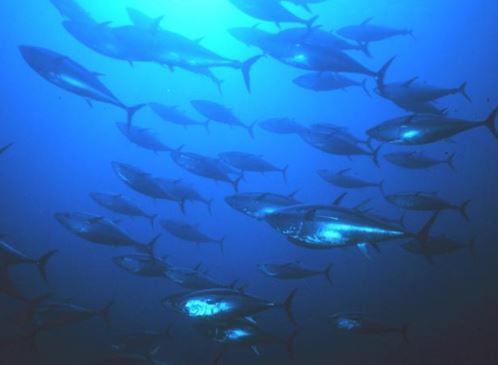This is special to the Mirror by Khyber Little.
Unfortunately for the dolphins, in the early 1960s, tuna fishers began switching their fishing method from pole, hook, and line to much more efficient large nets that enabled fishers to catch many tons of tuna at one time. Speed boats chase down the dolphins, herd them together, and encircle the net around them. During this process, tuna stay with the dolphins and the two are captured together. These are called purse seine nets because the net is closed—like closing a purse—on the dolphins and tuna. From the mid-1960s to the mid-1970s, tens to hundreds of thousands of dolphins drowned each year when caught in the nets. Subsequently, their carcasses were thrown into the ocean as wasted bycatch. When this practice was brought to public attention in the early 1970s, purse seine nets were modified so that most dolphins were able to escape before the nets were pulled onboard the fishing vessel. A portion of the net is lowered underwater allowing the dolphins to escape. This modification greatly reduced the dolphin bycatch, especially in the eastern tropical Pacific where today more than 99% of captured dolphins are released alive.

School of Atlantic Tuna (NOAA Photo)
The concept of “dolphin-safe tuna” encouraged tuna fishers from other nations to cut dolphin mortality. The U.S. required that all imported tuna be caught at dolphin mortality rates comparable to U.S. fishing boats. By 1994, only “dolphin-safe tuna” could be sold in the U.S. (world’s largest market for tuna). By 1999, political and economic pressure was claimed to have reduced the worldwide dolphin mortality to less than 3000 per year. ”
“Check the label on a can of tuna fish. Look for evidence that the can contains “dolphin-safe tuna.” However, according to a 2013 National Resources Defense Council (NRDC) published report, much of the tuna sold in the U.S. is being falsely labeled as “dolphin-safe.”
Tuna from fisheries in the Indian Ocean, Sri Lanka, India, and the Philippines are especially suspect because of lack of enforcement of regulations, while tuna caught in U.S. waters and the eastern tropical Pacific can be expected to have been caught by means that reduce dolphin mortality. Bycatch may play a role when marine species become threatened or endangered. Species determined to be in imminent danger of extinction throughout a significant portion of their range are listed as endangered. Species are considered threatened if they are likely to become endangered in the foreseeable future. For example, all seven known species of sea turtles worldwide are either endangered or threatened. Many human activities threaten sea turtle populations including bycatch in commercial fishing nets, especially shrimp nets. Other threatening activities are commercial harvesting of adult sea turtles (e.g., for food), poaching of eggs, disturbance of nests, collision with ships, and ingestion of plastic litter.”
Source: Moran, J. M. (2018) Ocean Studies: Introduction to Oceanography (4th ed). American Meteorological Society.
Leave a Reply